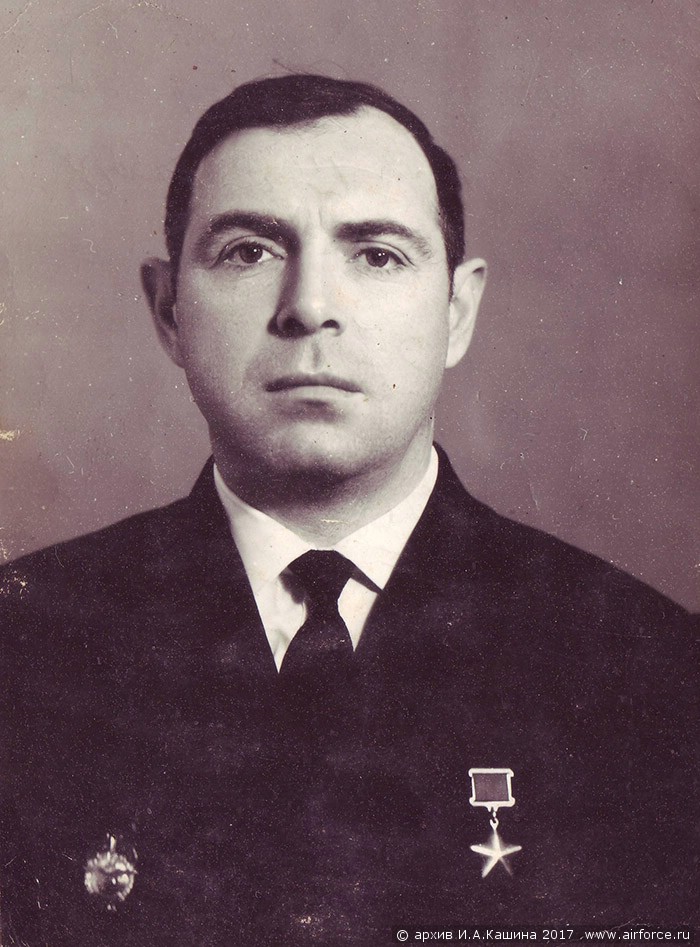 Ivan Andreyevich Kashin. 1973
Ivan Andreyevich Kashin. 1973
My name is Kashin, Ivan Andreyevich. I was born on 2 January 1937 in a village called Sakharovka, near the town of Yelets.
During the GPW dad was a locomotive engineer assistant, and his engineer was our neighbor. They had to run trains during the war. They were bombed and shot, their train was hijacked.
Dad died at the age of 87. Mom was born in 1911, passed away 1.5 years ago. She was a peasant, and worked until her last day.
I have an older brother. He used to go to school in the village, then to the FZO (practical training on the basis of some plant), then he was drafted into the army. He was born in 1930, but in his documents there was a mistake – 1929... He was drafted one year early.
I studied till 4th grade in the village. It was 5 kilometers away from town. Our teacher Petr Ivanovich was single, but then he got married to another teacher, and they taught us together. The school building is still standing, so I come see it each time I visit my village. Petr Ivanovich was a fisherman, and he got me into it.
Then we moved to the city. Dad was demobilized, so he had to walk daily for 10 kilometers to work at the Yelets railway station. We now lived in the suburbs of Yelets, in a village called Olshanets in a single room. My brother was drafted into the Fleet for 5 years.
It happened so that we graduated simultaneously from the same school. I studied in school full-time, while he was part-time.
– Was studying at higher grades commercial?
In higher grades – yes. I can’t recall from which grade, but we had to pay 150 rubles per year. It was a lot of money in those days.
– Did you work in summer time?
Of course. We worked in the potato and beet fields… All our classmates worked.
– Were you paid for it?
I can’t recall it…
– You were in the occupied territories during the War?
The Germans had occupied Yelets. We lived about 5 kilometers away from it. The Germans had captured the town, then our troops kicked the Germans out. I remember «Katyushas» that were standing by our wall at day time. At night they were moved to the yard. We got under the canvas to look at it, but nobody cared about us. Then I remember POWs moved to the south, but I do not know where too.
– When did you graduate from school?
In 1955, after 10 grades. After graduating from school, I got a note from the drafting board and applied for a place in military school.
In order to be able to go there I needed money. One crippled man had gathered us for carpentry. We earned a huge sum of money – 800 rubles. I gave them to my parents, besides money needed for travel.
I and my friend got an invitation. His brother was in aviation, while mine was in the Navy. I wanted to be a sailor, while he was into flying. We pulled matches to choose where to go. I lost, and we went to Sasovo, where I successfully passed all the exams. But my friend did not make it…
Our living quarters were in a former prison. There were thick walls, and it kept cool even in the hottest days.
We began flying the Po-2. When we reached the skies it appeared to be so beautiful: square fields, black earth, green grass… Our main airfield was Shatsk, 40 kilometers away from Sasovo.
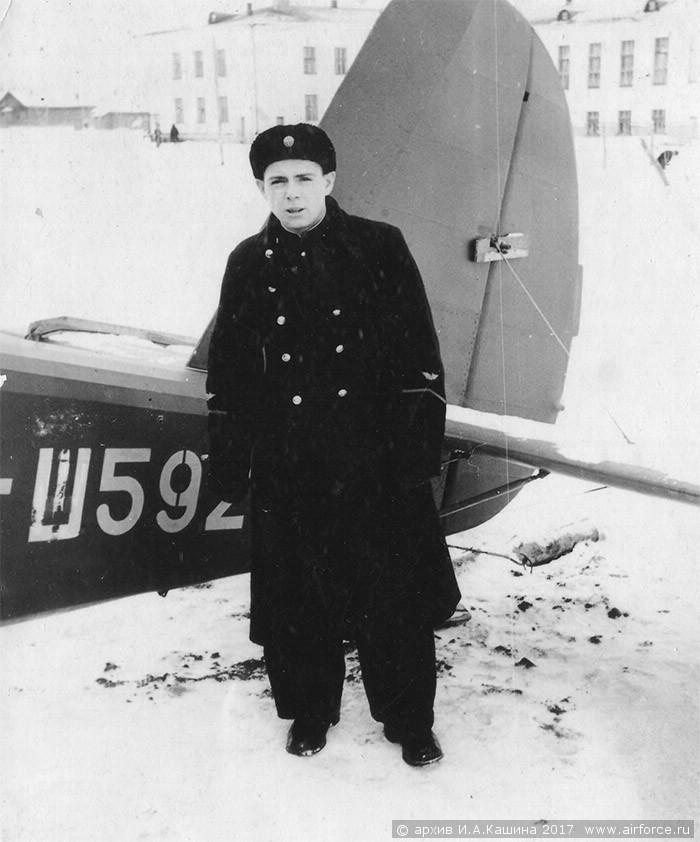 Student Kashin next to Po-2
Student Kashin next to Po-2
I was the first in our group to make a solo flight. My instructor Grishuk had graduated from Sasovo, got married, and stayed there as an instructor.
I do not know why he decided so, but after one of the flights he said to me:
– Stay in the cockpit, you will fly with the flight commander.
I flew for the second time, but when I began unbuckling:
– Sit still! You will fly with the squadron commander.
Wow! But there was no difference with whom to fly. So I did, he:
– Stay there, you will fly solo.
And I did. There was a sand bag in the front cabin for balance… When the bag was placed there, I thought – «There is no one to swear at me anymore». First turn, second, third…
We flew the Po-2 for one year, then we began studying the Yak-12 in the second year.
There was a month of vacation in between. I visited Yelets, the travel was paid for and it was the first time I showed up in uniform.
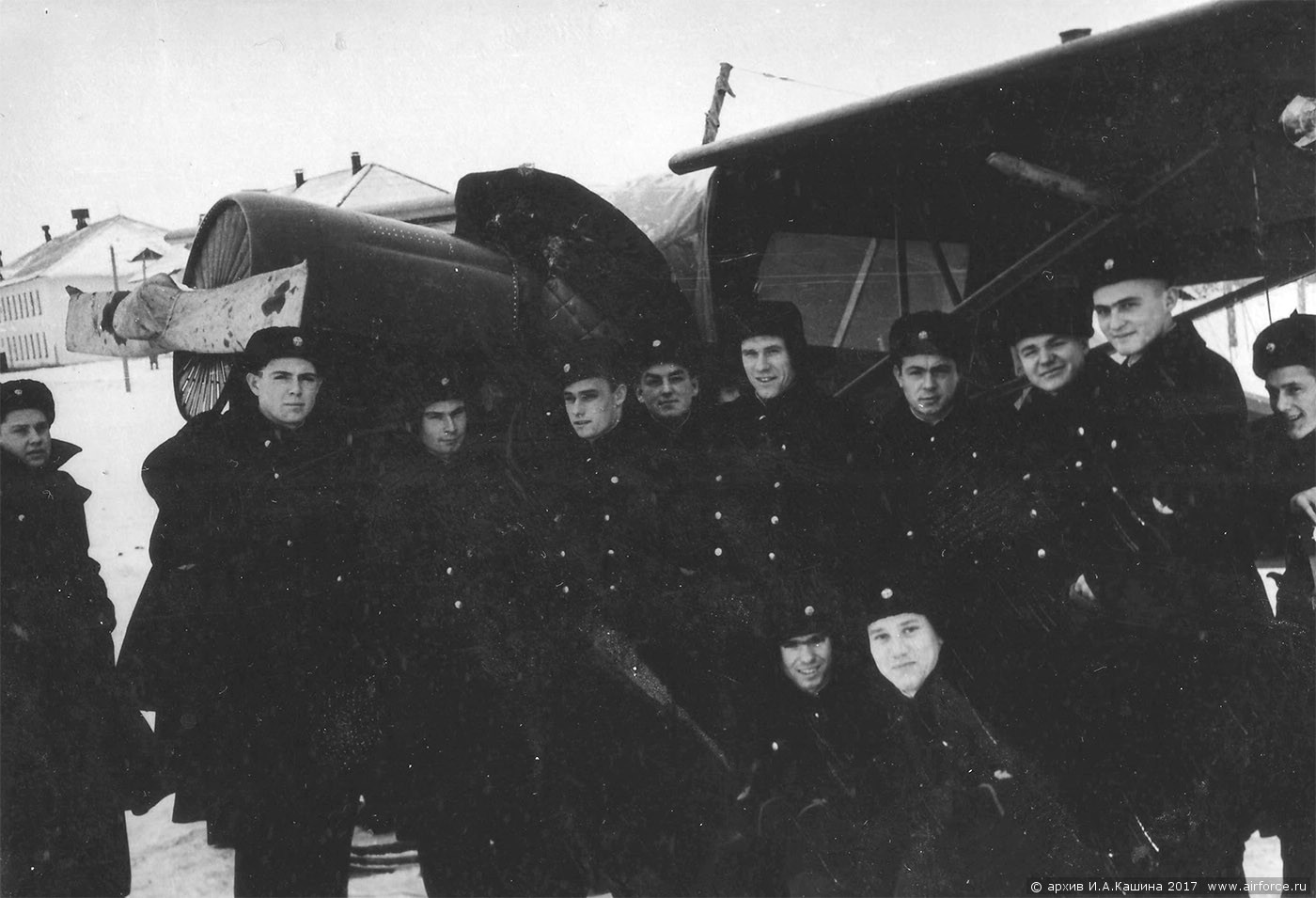 Students next to Yak-12. Kashin - second at left
– Were you living in barracks?
Students next to Yak-12. Kashin - second at left
– Were you living in barracks?
In barracks, 200 men – “old men” and “greenhorns” together. We lived in peace. I’d say – “in peace” is the wrong word. We lived in friendship.
There were 4 flight detachments, each consisted of 2 squadrons, and a 5th one was former military pilots training to fly helicopters. They used to fly all kinds of airplanes before that. After demobilization they were accepted to this 5th detachment.
We used to live in wooden barracks, by the second year a new, 2 story high building was raised. The first squadron lived on the first floor, the second on the second, there were dressing rooms and sanitary provisions.
We used to go out. We couldn’t cross the river by railway bridge, because it was guarded. There was a ferry there, but it did not work in the evening.
Once, somebody called from the city, and a man on the watch yelled:
– Our men are being bitten in the city!
All the cadets rose as by command… Only the men on the watch stayed. We went in like a cloud and dispersed those civilians.
A new problem appeared – how to settle us down. But it was done fast, and by the evening we all were home. The boys from the city did not dare to mess with us again.
– How much military practice did you have?
I can’t even remember. Not too much: drilling, some competitions, throwing grenades, shooting… That’s about all.
– Did you have parachute practice?
We had to perform 2 jumps in the school. But I made 4. One cadet was operated on for appendicitis, and doctors forbade him to jump. The chief of the parachute service:
– I don’t give a damn, who is going to jump! I want to see the parachute open.
So I had to jump instead of that cadet…
– Civilian pilots do not have parachutes. Was it really needed for you to jump?
No. When I jumped for the first time, I thought – «Oh! I want another one»! 2 or 3 days had passed, I thought – «Oh, crap, what if it will not open this time?»…
– There is a saying: – «A sane man will not change a working airplane for a piece of cloth»?
We had another saying: – «Jumping with a parachute is like kissing a tiger – lots of fear and no pleasure at all».
– Do you remember Stalin’s death?
Of course! 5 March 1953! Everybody on the streets were in tears, and everybody had one thought – «What is going to happen to us now – there is no Stalin to guide us anymore?».
We did not care who would take his place – they all seemed like pygmies by his side.
– And how did people react to Khrushchev’s rule?
I can’t say for everybody, but there were a lot unsatisfied with his rule. I worked as an An-2 captain then near Belgorod, and didn’t know that Khrushchev was overthrown. We walked into the kolkhoz office, and saw that kolkhoz chief take Khrushchev’s portrait from the wall, and start dancing on his face.
– That’s it! No more Khrushchev! We got rid of him!
When I flew to Moscow-Bykovo in an An-2 with passengers, cargo or medical flights, boys wrote me what to bring them and gave me money. I remember that I brought sausages in boxes, a couple of large bags of cigarettes. Sometimes, I had no time to buy something to myself…
A bit later, when I flew on a Yak-40 throughout the Soviet republics I saw that all of them were much better supplied with food and the rest than Russia. When I flew to Uzbekistan for the first time I went to a shop, and saw nylon shirts! I asked:
– And I really can buy them?
– Of course, dear, do buy them! Give me money and take it!
I bought 2, the engineer and co-pilot bought one each as well. I had no more money, so I sent a telegram, and got a wire transfer of 400 rubles. I brought a freezer with me. I got yelled at by my superiors. I replied:
– So, what bad had happened? The airplane flew back empty.
So, I got one of the first freezers in town, while my superiors had none…
– So, you began training to fly the Yak-12. Was it different to the Po-2?
Yes, we were even scared – flaps, slats, brakes, compasses, radio equipment… We began flying, and I remember we spoke:
– How did we fly the Po-2? No brakes, no accumulator battery, no generator…
And it had to be started by a pole with a rubber ring on the end that was used to turn the propeller.
I graduated as a Yak-12 pilot. After graduation we were sent to Moscow to the Civil Aviation Directorate for Central and Arctic Regions. Only those who had a place to legally live in Moscow had a chance to stay there.
I lived at my friends for a couple of days, thinking where to apply for. Then one guy said to me:
– You should go to Bryansk. There are 3 post lines there, and you will always be able to fly a norm of 300 hours.
On 1 October 1957 I arrived at Bryansk.
– Where is the airfield?
– Take a train to Bezhitsa, then to Zhukovka, one stop past Bordovichi…
For the first time I had to live in “Lenin’s room”. On the 4th day Sputnik was launched…
Mostly, there were old pilots, who flew the Po-2 during War time. Dmitrii Afonskii (Dmitrii Afonskii, fought in 582 detached signal squadon, ORS, OGPW II degree twice. Flew over 200 combat missions) and Vasilii Khlusov flew a Yak-12. Grigorii Ilyushin flew a An-2.
– How many airplanes were there in Bryansk those days?
1 An-2, 4 Yak-12s, and about 30 Po-2s.
The Bryansk detachment consisted of 3 squadrons – one in Bryansk, the second in Smolensk, the third in Kaluga. Our squadron commander was Konch.
(Ivan Konch. 690 NBBAP, OH III degree.)
I began flying the Po-2. Navigator:
– This is our route, you will have to keep orientation by the villages.
Once we flew, I looked for the village:
– I tracked considering time, course, wind…
– Why are you flying in circles?
– Here is some dark spot on the ground.
– Yes, there used to be a village here, but it was completely burned during the war…
– What kind of work did you do on the Yak-12?
Post service and a lot of “chemistry”. The Yak-12 could carry 260 kilos of fertilizers, while the Po-2 took 300.
– What was the altitude for fertilizing?
5 to 50 meters. If it was sanding well we flew higher, if not – lower. I remember that when we worked in the Ukraine, we suffered from cockroaches and bed bugs. Once we took some of the insecticides with us in a bag – and from that night on there were no insects in that building. And we did not even open that bag!
– What was your class?
I graduated as IVth. After gaining flight time and passing exams I got III. But that was already in Bryansk.
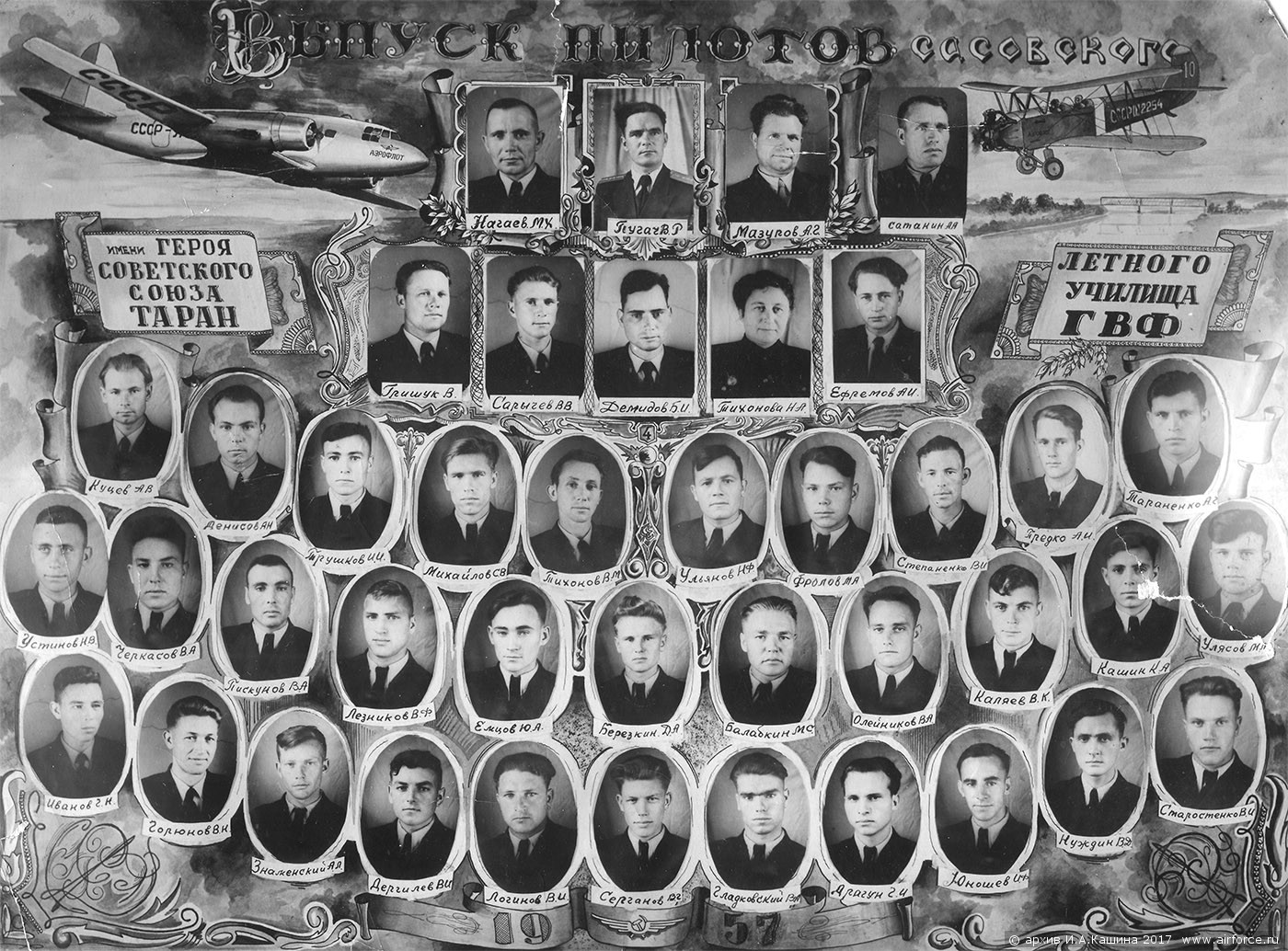 I.Kashin schoolmates
– Were there crashes or catastrophes?
I.Kashin schoolmates
– Were there crashes or catastrophes?
There were crashes on the Po-2. Vasya Khlusov once flew to Churovichi, that’s about 200 kilometers from Bryansk, and damaged an airplane on a hard landing. Our mechanic “uncle Kostya” took carpenter’s tools with him, carved broken parts from wood, painted and glued with canvas, and they were back in 10 days.
I had to make an emergency landing on the Yak-12, but rolled to the airfield’s boundaries. Something got broken in the engine. It was 12 April 1959.
I made it to the airfield when the propeller stopped working. I pulled on the stick, felt something pulling me on the tail, and then I landed right before the airfield border. It turned out that I caught a tree top with my rear wheel.
The airfield border was marked by a white stripe on the ground. My airplane rolled across it, and stopped inside the airfield boundaries – so there was no need to report a forced landing.
Once I had to make an emergency landing on an An-2. It was April 17. I just finished the fertilizing pass, turned around when the engine began shaking… I pulled up, but this caused the speed to drop. I checked for fuel quantity – but it was enough.
Where to land? The altitude was no more than 50 meters. The fields were soaked with water, so landing there would end up in overturning… I noticed smoke coming out from the cowling, oil was covering the windscreen.
Arkadii Glogov – co-pilot, 117 kilograms of live weight, asked:
– Should I report?
I replied:
– Wait…
Then I noticed an earthen road! There was nowhere to land besides it. There was a plowed field on the left and bushes on the right… I have no idea how I managed to land. I got out of the airplane, and saw a GAZ-67. Its driver asked me:
– And what is the reason for your landing?
I asked:
– Where did you appear from?
– You flew over us on landing.
– I didn’t see you. I have a faulty engine.
We opened the cowling and saw that it was oil smoking.
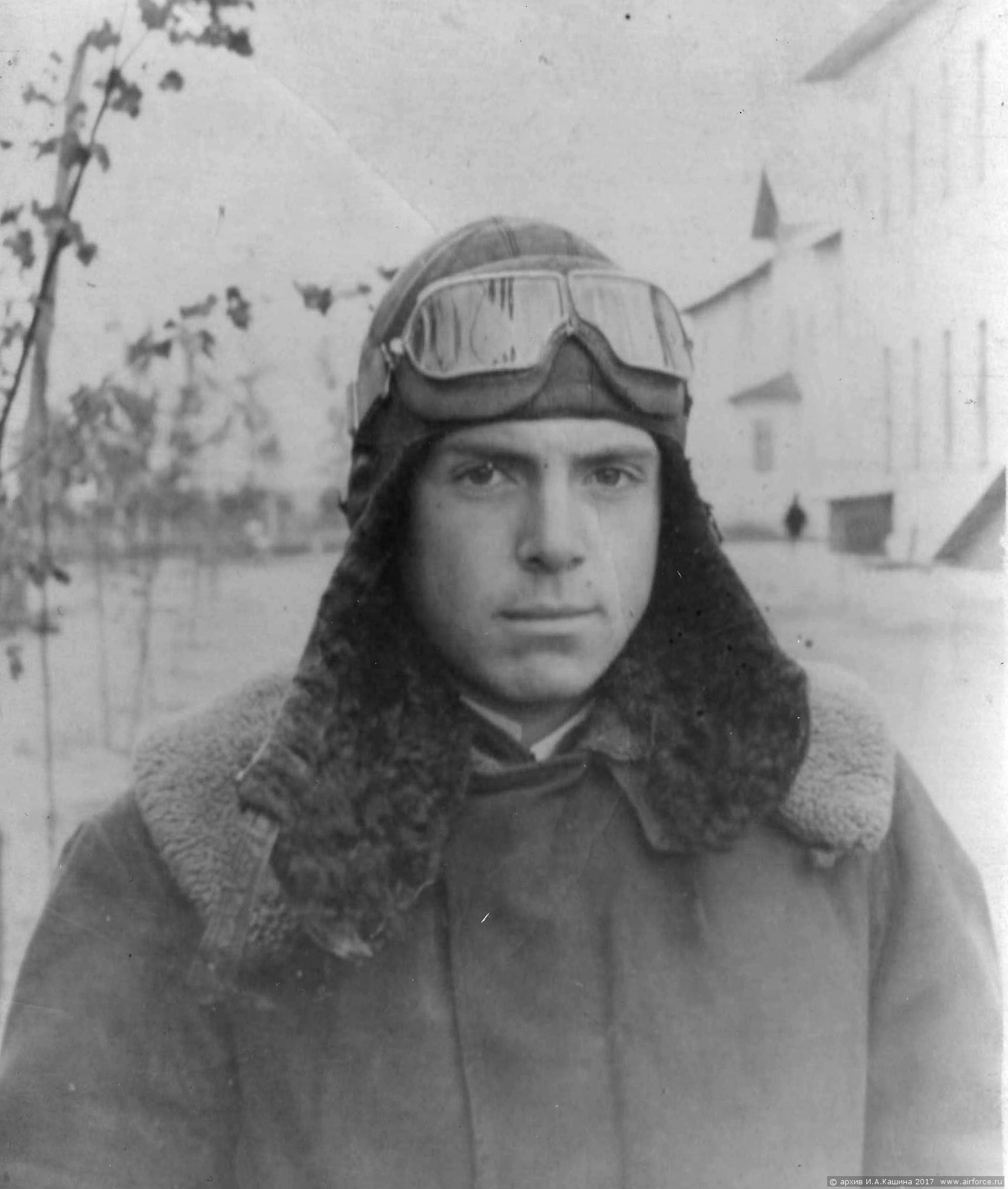 I.Kashin
I.Kashin
I told Arkadii:
– Now you can let them know.
Once he got on the radio, everybody in the air shut up. The information was passed to the airfield. That road was so narrow that there was no possibility to reach us besides that GAZ.
We spent a night there. In the morning a ladder was brought by a horse. We found out that there was a spark plug missing in the upper cylinder. There were 2 plugs in each cylinder, one was ripped out, while another kept igniting the fuel mixture.
We fixed the cylinder when the squadron commander came:
– What are we going to do?
I said:
– Take off.
He:
– What do you mean?
Wheel to wheel 3,600 mm, and road was just 4 meters wide. I got in the left seat, he in the right:
– I have no idea, how you will do it. It is fully your choice. It is impossible to stay on this road.
Well, if he said «your responsibility»…
– Arkadii, get in. Once I start rolling, get flaps out on my command.
About 40 students were brought to turn the airplane against the wind.
– Ready?
– Let’s roll.
I pushed the throttle forward:
– Get the flaps out.
We took off… Gained 50 meters. Flew over the crowd and headed to the airfield.
– When did the An-2 begin arriving at Bryansk?
When we came to Bryansk there was one An-2 already – СССР-5599, flown by Grigorii Ilyushin. Then its number was changed to Ш-55599.
The An-2 was built in the USSR and Poland. We used to fly up to 100 hours per month on it, 1000 per year. I soon was promoted to a crew commander.
There was a time, when there were a lot of co-pilots coming, and there was not enough work for them.
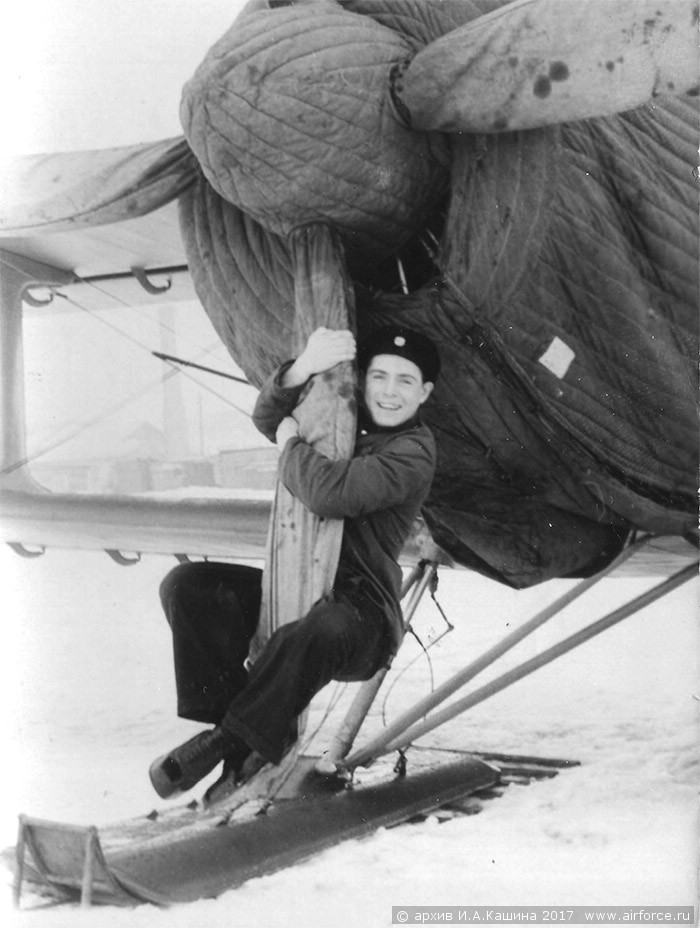 I.Kashin next to An-2
– How long did you fly the Yak-12?
I.Kashin next to An-2
– How long did you fly the Yak-12?
About 3 years. In 1961 I finally was assigned to the An-2 as a co-pilot.
I trained as an An-2 pilot in 1958 in Voronezh. At first I flew with Grigorii Ilyushin at “chemistry”, then I was transferred to another squadron in Smolensk to fly the Yak-12.
There were 2 of them there and no one to fly. Then I got transferred to Vyazma, where I had to work as a pilot of a Yak-12 and co-pilot of an An-2.
Once we celebrated October Revolution day, and there was very poor weather. My friend suggested to me to go to the dance. There I noticed a girl that was having problems with boys that had too much [to drink]. I sent them on their way, we stood with her, I led her home, and returned to Smolensk.
Then I visited her once more, we went to the movie, then we pen-palled, and I proposed to her in the letter. She agreed, and I lived with her for 56 years.
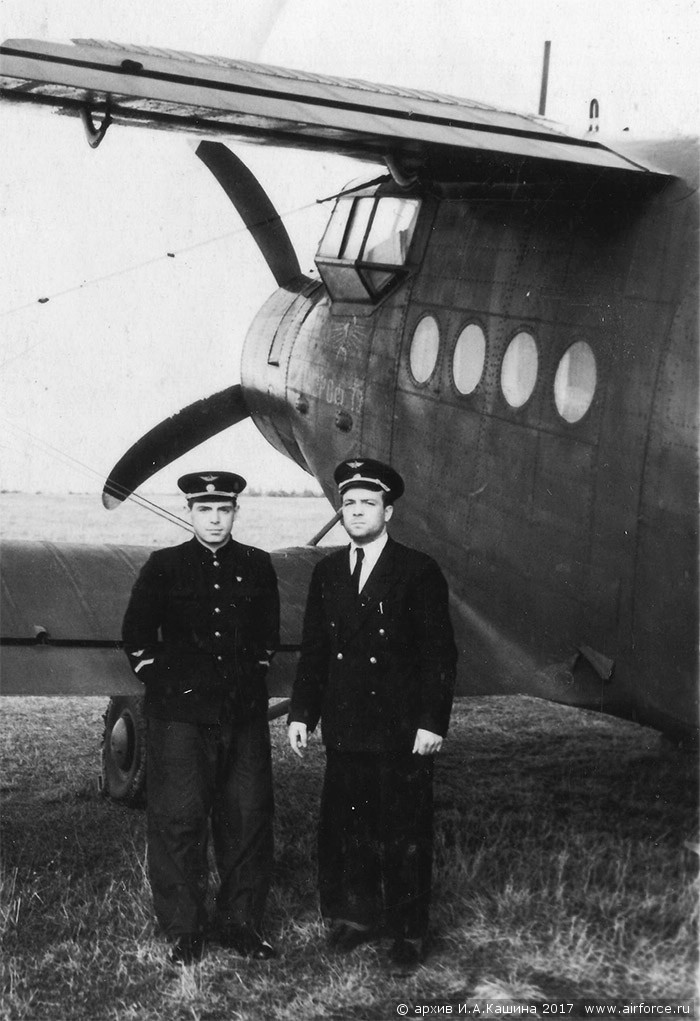 I.Kashin (left) next to An-2
– Did you have long flights in the An-2?
I.Kashin (left) next to An-2
– Did you have long flights in the An-2?
It was not allowed to fly the An-2s at night, there was a special training program. We flew long routes to Gorkii often, Odessa…
– How long did it take?
The cruise speed was 180 km per hour… I had to land in Kiev-Zhulyany for refueling when I flew to Odessa.
– There was an airfield in the middle of Bryansk?
The old airport was in the middle of the city. That’s where I began working from. A new one was constructed in the suburbs in 1992, right when I became a pensioner – my wife demanded me to quit work.
I once flew to Spitak, Leninakan. Its airfield is at an altitude of 1500 meters, with a normal pressure of 636 mm. hg. There were a lot of plane wrecks there! Even the Il-76 had crashed there.
(There were 2 Il-76 crashes in Leninakan area with identical causes. 1: Il-76m CCCP-86732 11 December 1988. 2. Il-76td CCCP-76466 20 October 1989.)
The third turn is made at an altitude of 1100 meters with an air pressure – 636, while they had 736. Each millimeter of pressure equals to 11 meters of altitude. They stole 100 millimeters from themselves, which equals to 1100 meters. They were actually scraping the earth surface, when they began banking to turn. The wingtip caught the ground. Airplane wrecks had been dispersed for over 6 kilometers.
Engines were starting poorly there, so it required a great deal of expertise to fly there. One former squadron commander after his first flight there said to me:
– Don’t even bother explaining to me the secrets. I will never fly here again.
The runway there was 3200 meters, but you took off from the last inch, and that in a Yak-40. And another moment: after an earthquake the runway was broken with large cracks in the ground. They were covered with earth and rubble, but the Yak-40 had large wheels that could withstand the pressure. Once you lifted off your actual altitude wouldn’t raise for a minute or so – your radio-altimeter would keep showing 1-1.5 meter.
Another difficult airport was Stepanakert in Askeran valley. The mountains there were 1000 meters away from each other. You had to visually fly till the bridge over a dry river, which had water only during spring time. You flew there with a course of 178 degrees for 6.5 kilometers, then you made a turn and flew right into the mountain side. Cows are looking at you from above…
The feeling there was very unpleasant – it seemed that you were going to crash. When we had landed I looked along the runway, and a mountain was right in front of it. On paper it is 1° off to the side, but in reality it is straight in front.
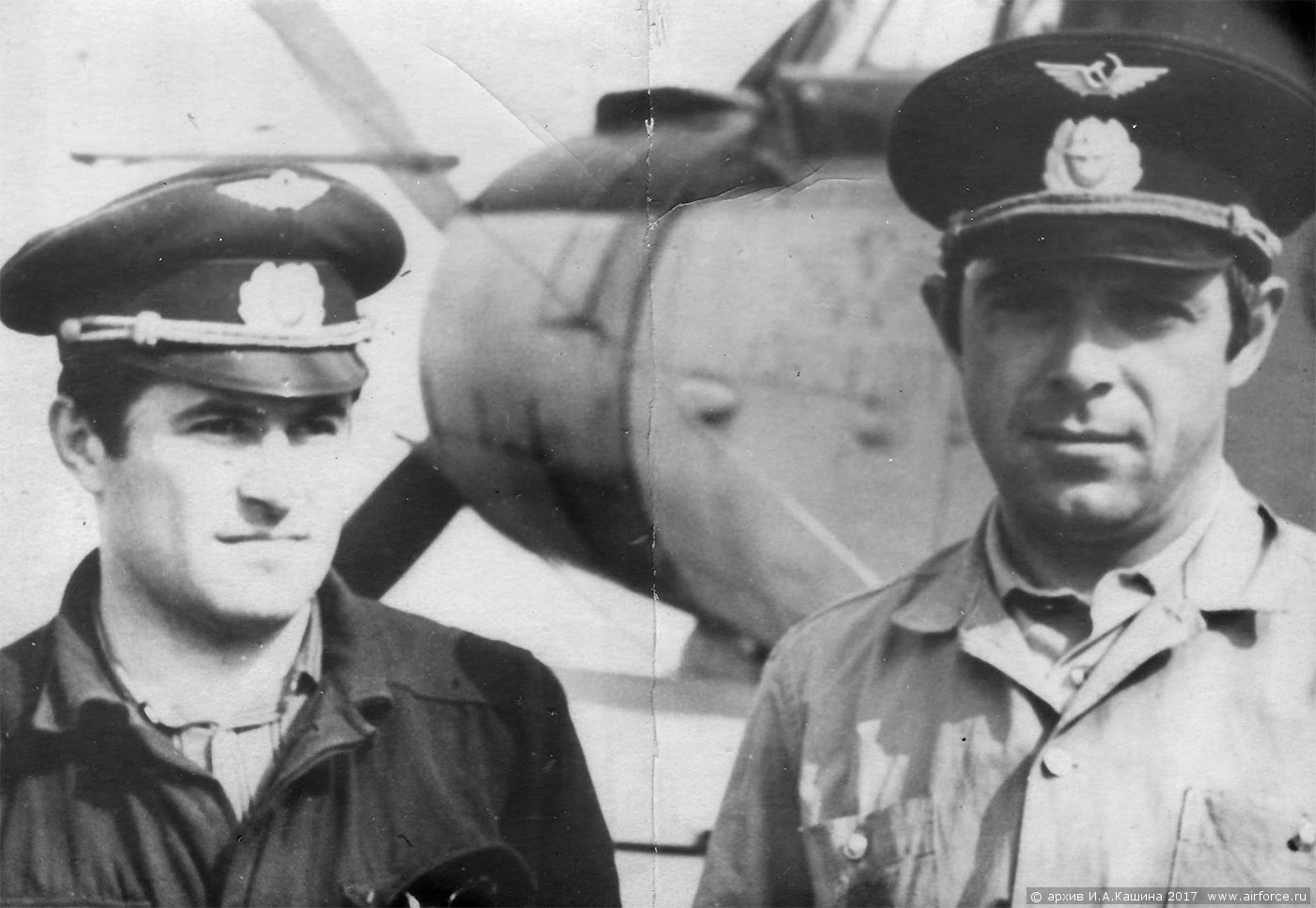 I.Kashin (right) next to An-2
I.Kashin (right) next to An-2
I asked:
– How could this happen?
– Otherwise no airplanes can land here, except the An-2 or helicopters.
We flew there regularly, each Saturday, and I had to fly all the flights by myself – other pilots refused to fly there. One of my co-pilots described how we flew to his wife, she spoke to mine, who in turn demanded that I quit flying:
– It’s either me, or airplanes!
I went to the doctor:
– Are you sure?
– I have no choice. I don’t want to divorce.
– Then you should complain about heart problems.
So I quit in 1992, after 11 years as a squadron commander.
– When did your enterprise receive Yak-40s?
In 1968 I applied for retraining to the Il-18 with a further transfer to Moscow. But our training was cancelled, because another crew was given our place.
Then, when I was crop dusting I was summoned to HQ:
– Would you like to train for the Yak-40?
I replied:
– What for? With a transfer to Moscow? I don’t want any more.
– No, we will be receiving our own.
I agreed. After training I had to work in Moscow in 1968-1969 as a co-pilot.
In 1969 we received 2 airplanes from Moscow – 87631 and 87632 and began flying regular flights.
It was 1971. I was qualified as a crew commander in 1972, and our hijack happened in 1973…
– How were you fed?
We had a coupon worth 5 rubles 55 kopecks for each meal. You go to the canteen of the airport where you were, and you were fed. When we flew dusting missions we were fed by locals. We usually lived at someone’s house, and they gave us whatever they had for themselves. I remember that those days all the republics lived more or less well, while the supply in Russia was very poor. We mostly had millet in all possible ways of cooking it.
– Where did you fly agricultural missions?
We flew a lot of them. At spring we started to work in the Odessa region, then we moved to the North, as snow melted, as far as Moscow…
– What kind of Yak-40 did you get? 3-, 4-, 6-ton version? With or without reverse?
Wow, you do know about airplanes! 631, 632 and 607 were 3-ton ones. Then we received the 4-ton version. Their full fuel capacity was 4400 liters. 3-ton airplanes couldn’t reach Leningrad, while 4-ton ones allowed us to fly there. Leningrad was over 1000 kilometers away, Odessa 900, Rostov over 900, MinVody [Mineralniye Vody], Sochi, Donetsk about 600-700…
The first airplanes had 27 seats, then we got the 32-seat version.
I remember, I brought one Yak from Khanty-Mansyisk in a luxury version. It was equipped for carrying supreme party officials. It had a table, arm chairs, 2 toilets, wardrobe, and an audio system. But it did not fly a lot.
– Did you get new airplanes, or used ones?
The first ones were 87631 and 632 which flew in Moscow. Then we got 607. Then we mostly received new ones from the plant in Saratov. We had about 10 4-ton ones. When I was a squadron commander we had 33 Yaks at the same time. We got both used and new ones. We had a lot of routes – MinVody, Sochi, Odessa, Simferopol, Kiev, Rostov, Kuibyshev…
There were so many passengers, that we had neither crews, nor airplanes to carry them. A ticket to MinVody cost 31 rubles, Sochi-30, Moscow-14. We had 4 flights daily to Moscow in the Yak-40 and 4 in the An-24.
And now our town has almost no air connection, so the airfield is wasted…
– What can you say about the Yak-40?
It was a toy. It was easy to fly, had triple backup for controls. It could land at any airfield with a runway of 1000-1200 meters. The first ones didn’t have an autopilot. 607 had none, and some other too. 631 and 632 were already equipped with an autopilot. At first it was not so good for cargo loading, but then we got the Yak-40K version with a side door and the possibility to remove the seats.
– In 1970 the father and son Brazinskas hijacked an airplane. Were you informed about it?
It was such an international scandal, that everybody knew everything. But speaking of accidents, all pilots received information about each and every accident that took place everywhere in the Soviet Union.
– How did your hijack began?
I returned from Moscow where I attended the burial of my uncle, who used to be a special ops man. He got 6 medals “For Courage” during the War and later worked as a policeman…
I was sent back to Moscow right after my return. The weather was poor, but I landed well in Moscow-Bykovo, and was on a return leg to Bryansk. These 4 bandits boarded in Moscow.
– Do you remember which airplane it was?
Yak-40 СССР-87607, an old 3-ton without a reverse or autopilot (Yak-40K built in Saratov, bort No: СССР-87607. In use from 23 July 1971. In 1987 transferred to CNIIMASh. Further fate unknown – supposedly disassembled for scrap in 1990s.). We had no flight attendants, and a container with candies and mineral water was near the front door. If somebody wanted a candy or water he might take it himself – self-service. Instructions for the Yak-40 demanded the cockpit door to be closed all the time.
My crew consisted of me, co-pilot Stanislav Talpekin, who was making his first flight as a Yak-40 pilot, and flight-mechanic Nikolay Nikitin, who lived in the same apartment building as I did.
When the hijack started, the flight-mechanic heard the clinging of the bottles. He opened the door to take a look in the cabin, and saw the barrel of a gun pointing at him. He hit it, and tried to close the door, but the tip of the barrel got caught and did not allow for the door to be closed.
Nikolay then told us:
– I saw the tip of the barrel turning upwards. I moved to the side right before he fired.
Hijack! I pressed the secret switch, and the ATC [air-traffic controller] immediately asked:
– 607, are you under attack?
– Yes.
– Your decision?
I replied:
– I will land in Bryansk.
– Understood, you will be cleared to land.
The flight-mechanic was dragged out of the cockpit by the bandits, he stood up, grabbed 2 shotguns at the barrels, but the third one shot his stomach. Somehow, a Jakans bullet flew through his body without damaging the internal organs, leaving only the container in the wound. Nikolay fell down. A passenger attempted to fight the hijackers, but he was also shot – a bullet hit him in the right shoulder. But a shot next to the ear does shock you…
– Did you suffer from decompression?
No. I wasn’t even thinking about it – the conditioning system worked fine.
The hijackers decided to get rid of one of the pilots – they believed that one pilot was more than enough. It fell on me. They fired through the wall in my direction. A Jakans bullet is a soft lead one, so it flew through the wall, radio equipment and hit my seat with no force. I looked back and saw a hole in the wall about 2 cm wide.
Then they began hitting the door. Slava tried to close it, but a dent after the shot did not allow him to do it properly. He held the door with his body.
There was a yell:
– Open the f*cking door!
And swearing. Slava looked through the peep lens, saw the barrel of a gun, and told me later:
– It was looking into the barrel of an “Aurora” cruiser gun.
Right after he ducked they fired. The bullet hit the radio station. It was still working, but we couldn’t change the channel.
Slava took the fire axe and used it to block the door:
– Let’s fly.
We were already past Kaluga, we even started the descent, when the door gave way – the axe had fallen out of the handle. I was at an altitude of 400 meters, landing gear and flaps down, ready to land. The door opened, barrel pressed to my head, and yelling with swearing:
– If you will try to land, we will start shooting the passengers. Divert to Moscow.
There was an instruction: «In the name of saving passengers do all that is requested by hijackers».
So I did. I was off the route a bit, so I had to make corrections, and we also had a strong headwind, I even had to lower to 4500 from 5700. Then we began receiving strange questions from the ground:
– Crew commander, are you a member of the Communist Party?
– Yes.
– And the co-pilot?
– Yes.
– What about the flight-mechanic?
– He is also a Communist.
– A-ha…
And then silence. It turned out that 2 fighters were raised from Oryol and trailed us, waiting for a command to bring us down. It was discussed whether to let us try to land in Moscow or not with such a load. When we reached Serpukhov, we got clearance to land in Vnukovo. The ATC asked me:
– Would you prefer a straight landing, or a box?
– I can’t fly a “box”! I’m on vapors!
– Right, you are 19 km away, 400 to the left.
Then:
– 13 away, 200 to the left.
I decided that the wind would drag me to the runway, so there will be no correction needed.
I switched the blind landing system on, and it made me feel safer. At about 4 km off the runway system I caught the beacon. I descended without seeing a thing… Fog, fog, fog… No approach light, nothing. 50, 30 meters…
And I had no other options but to land… One “low fuel” lamp had lit solid, another one flickered, when I finally caught green lights for a second. The radio altimeter showed 0, but I still was in the air. Suddenly I felt the wheels catching the runway. I landed perfectly, like I hoped to land on a usual day! And I was still unable to see the direction lights. Vnukovo had a wide runway used even by the Tu-114. When I landed the ATC said:
– Move to the main taxiway, you will be met there.
Vnukovo had 2 runways. I moved to the left side until I saw the white lights, then blue ones. Then I noticed a “follow me” car.
I followed its lead till the end of the runway, then the car turned around and left. Dispatch called:
– Turn around and move a bit forward.
I did as instructed. The hijacker shouted:
- Stop! Stop!
I pressed the pedal a bit:
– You see – I’m braking! But you must have damaged something.
Dispatch:
– Stop here.
I stopped:
– I finally made it.
The hijacker was standing behind me with a sawed off shotgun. They had a sawed off shotgun, a single barreled shotgun and a twin barreled shotgun – 3 were armed, and the 4th had a “diplomatic” suitcase with ammunition.
Then trading began. I had landed at 12:00, maybe later, and talking lasted until 17:20.
It was agreed that the wounded would be removed from the airplane. They were bandaged by Vladimir Gaponenko’s wife – he was the one who tried to interfere with the hijack. Vladimir had died a few months ago. They were flying to Bryansk with their 3.5 year old daughter Larisa. Larisa spoke to her mother, it was dead silent, so I heard:
– Mom, which one killed our Dad? Mom, who is going to kill us?
One bandit shouted:
– Shut the kid up!
The wounded were carried away on the stretchers by other passengers, while the hijackers looked that nobody else would escape. Slava went out to refuel the airplane. I said to him:
– Do not return.
Slava fueled the airplane and returned. I asked:
– Why did you return?
– How could I leave you?
Bandits wrote a note in the air: – «You will give us 1,500,000 dollars, we will leave everybody alive and give out 2 groups that are about to hijack Tu-154s». That is by word, I still remember.
The hijacker saw an APC [armored personnel carrier] going past the right wing and got excited. He thought that it was money being brought. But the APC had no roof, and I saw the tips of bayonets of the assault team.
It was arranged that 750,000 dollars would be given in Moscow, then we would fly to Leningrad, where we would be refueled for 1500 kilometers, 750,000 dollars more would be handed to the hijackers, and we would fly to the USA. That was their plan. Slava Talpekin opened the books looking for the Pulkovo approach parameters. I said to him:
– Stop this nonsense. We will not leave Moscow under any condition.
– Their plan was unrealistic.
But they did not know that. They were… uneducated fools. Instead of a proper map, they measured the distance by a ruler on 2 drawn hemispheres from a school atlas! 2 were intending to live a pleasant life with no working in the USA, the third was found insane and sent to a madhouse. The 4th was a kid who wished to fight the American government on the side of oppressed native Indians.
The assault group was led by Popryadukhin. It was the first ever assault in the history of Soviet aviation, so they had no equipment. They picked a ladder, pole, and an axe from the fire stand…
They were hiding under the airplane, and somebody hit the fuselage from below… the hijackers opened the door, the assault team blocked the door with a pole. Somebody shouted, as Slava said later:
– Shoot the passengers! We were fooled!
There was some shooting, when the ATC asked if there were passengers wounded.
I looked outside from the side window and saw somebody on the ground… I did not know who it was, but then noticed that he was in jeans. All other passengers were dressed in suits, except these 4 – they were wearing jeans. I remember that I saw a pen on top of him, which looked like my friend had presented me: – «Wow, how did he get my pen…» I was told that it was a bandit. Then I noticed somebody with a large camera on his shoulder filming the assault.
A CN grenade was tossed into the cabin, my nose and eyes were running, shooting was going on, and the camera operator was still filming. He walked towards us… the APC had fired 2 bursts at the airplane.
I turned away from the window, and Slava said to me:
– Look, if you wouldn’t be looking outside, a bullet wouldn’t end up in your head.
I turned around, and at this moment a second bullet flew where my head was a moment ago…
The hijackers yelled:
– We give up!
I sent a message:
– Stop shooting, they give up.
Everybody ceased firing. One with no weapons tried to jump out of the plane and was shot midair. He was lying near an airplane, legs to the tail.
Their chief shot himself, 2 were in the cabin. One with a double barreled shotgun jumped out and was caught. The 4th decided to run out of the tail door. He dropped a gun, and then passengers began tearing him apart. He was hippy-like, with long hair, so most of it was ripped off...
An apparel [a built-in ladder in the rear] was not working properly, so the assault team had a setback before they dragged him out.
One technician, who was flying as a passenger, tried to run out of the cabin, and was wounded. All wounded were sent to the hospital.
2 men looked inside the cockpit:
– Get out!
I turned around and looked at their pistols. I replied:
– The co-pilot will go out. I’ll stay in touch with the ATC for a while.
Slava got dressed, and they went outside. Once he got out 3 men from the Directorate of Civil Aviation started asking him. I followed them. I saw 3 men – Chief of the KGB Andropov [Yuri Andropov, later head of the Soviet Union], Head of Civil Aviation Bugaev and I think it was the Minister of Internal Affairs Schelokov. I recognized Bugaev, so I reported to him:
– Crew commander Kashin…
And so on… He:
– Great work, everything is fine. Get dressed, it is cold outside.
I returned to the airplane, took our 3 “diplomats”, and then I noticed that Slava had taken my coat. That’s why he was attacked by officials from HQ. They asked him:
– Where is what? Show us?
He talked and showed. Then they came to the body of the hijacker, who brought the ammo. Somebody asked from behind:
– Who is it lying? A passenger or a bandit?
Slava replied without turning:
– How the f*ck should I know? Oh! He is in jeans. It’s a bandit.
Somebody whispered:
– Don’t swear in front of the Ministers!
Slava looked back:
– F*ck again!
There were Bugaev, Andropov and Schelokov before him. That’s when I came out of the plane. He gave me my coat back:
– Take your coat! It’s full of holes...
Everybody left. A man looked out of the last car:
– Come on, let’s go.
I got dressed, and we were taken for interrogation. It was about 19:00. We were interrogated until about 03:00, and then we were taken to a Vnukovo hotel.
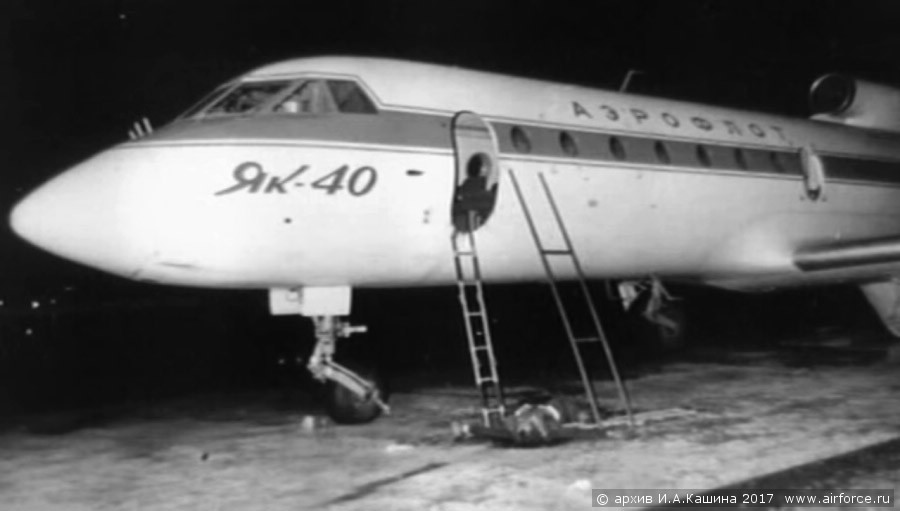 Yak-40 after being stormed by special forces
Yak-40 after being stormed by special forces
We had something to eat, spoke a bit, and fell asleep. Then I heard Slava:
– A-a-a-a!…
I punched him – he stopped. In the morning I asked him:
– Why were you shouting in your sleep?
– I was sleeping! It was you that snored all night long.
Then we had breakfast and another interrogation, which lasted for no more than 10 minutes. I asked to see the wounded. We were loaded in the minivan and brought to the hospital. We were not let in, but we were told that our flight-mechanic had 2 operations…
Then we were summoned back to the prosecutor’s office for further interrogations for an hour or two. After that we were sent home with the crew from our enterprise. While we were flying back we dreamed of drinking a bottle of brandy, that we bought with our last money. But when we came home, we were met by our wives and all the time some other pilots came in – and we talked, and talked and talked… It was Slava who did the talking – he saw more than I did.
– Weren’t you armed?
Pistols were issued to the crews in border regions – Sukhumi, MinVody, Kaliningrad. Leningrad was also armed.
But Moscow and the internal regions were not issued weapons.
– But still, what if you had weapons?
If we had a single pistol, we would have shot them all after the first round was fired. But we had no weapons. I was fully ready to shoot them.
– What happened to the airplane?
It was sitting in Vnukovo for 3 or 4 months. It was impossible to get rid of the CN… and besides, it was depressurized – there were 68 bullet holes on the left side and 28 on the right.
– Who they were shooting at, if they could not see the targets?
I don’t know. When we were fired at, somehow bullets flew into the cockpit. It was wet weather, and the floor mats were wet. Bullets fell down, and hissed, when Slava melancholically stepped on them. There were about 4 bullets on the mat eventually. There was a hand rest at the left side of Slava’s seat, and a bullet flew right through it from behind.
Somewhere around spring the airplane was flown to Minsk for repairs. It was fine, even fuel remained in the tanks. Then it was returned to our unit. I was a squadron commander in 1982, I believe, when I was summoned:
– Your airplane is going to be transferred to another unit. It should make an acceptance flight. Will you do it yourself, or?…
– I will do it myself.
So I did, walked around it for the last time, said my farewell, and they flew away. СССР-87607. I do not know what had happened to it afterwards.
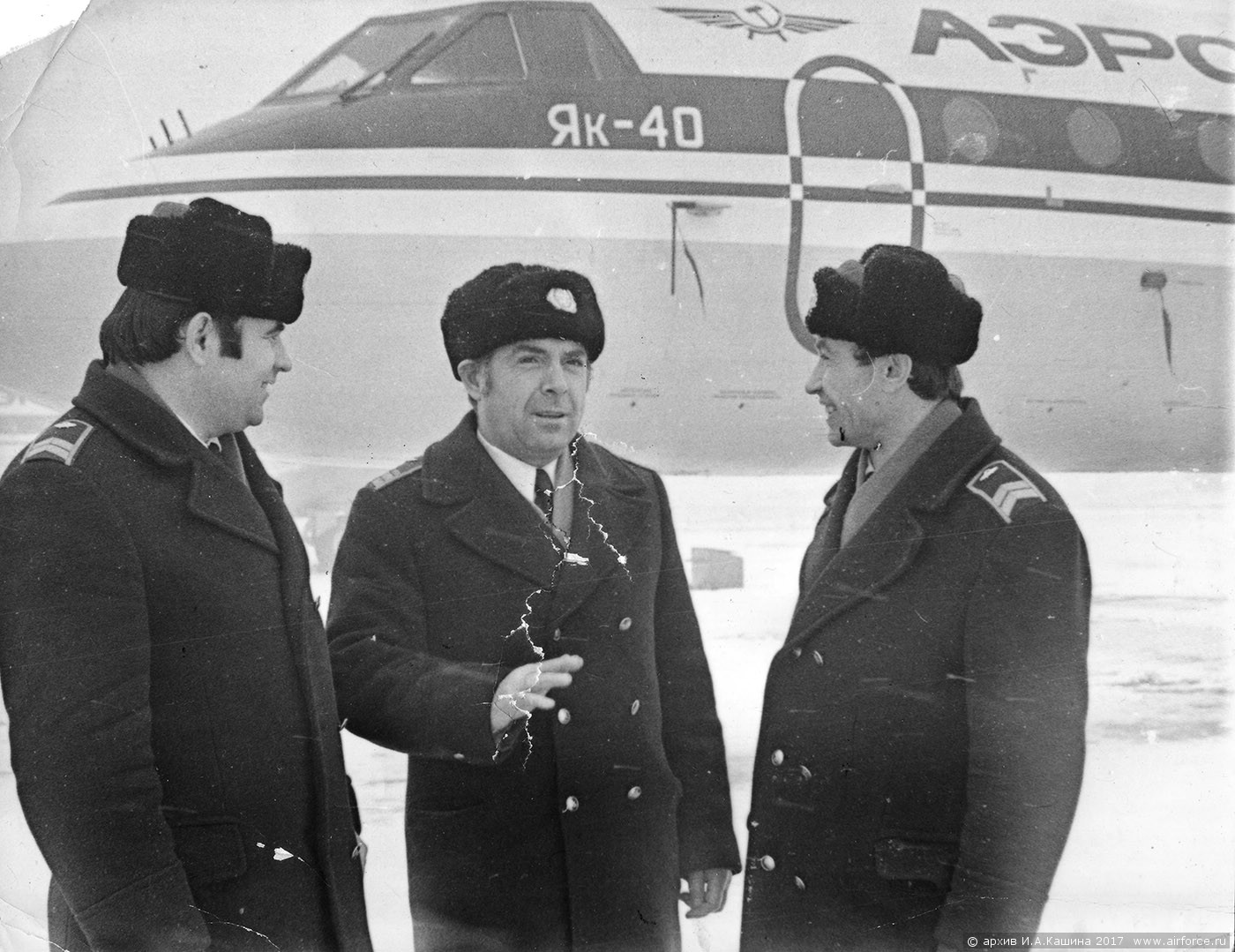 I.Kashin (in a middle) next to his Yak-40
– Did you expect to be awarded with an HSU title?
I.Kashin (in a middle) next to his Yak-40
– Did you expect to be awarded with an HSU title?
We thought that we would be thrown out…
– That’s it!
– And we were not even tired of flying…
That’s what we said to each other.
– When did it become known that you would be awarded?
We were at Bryansk, when somebody said:
– You are going to get some!
I asked:
– What? Punishment again?
– No. The passenger will get the ORS, the co-pilot will get the ORS, and you will get the HSU.
I couldn’t believe it:
– What?! No way! That’s crap…
But one week later it was confirmed, then we were told that it had been approved.
I had flown my norm, and went to visit my parents. All our relatives had gathered there. My cousin Raisa began describing what rumors were said about our case. I was sitting silent. I tried to say something, but she wouldn’t let me. Then a door bell rang:
– Here is a telegram. Who is Kashin?
My brother took it and said:
– Ivan, it’s for you.
– Let me read it.
– No, I’ll read it myself: – Bugaev. Congratulations on the awarding of the high title of HSU, Order of Lenin and Gold Star medal.
It went silent, then mom:
– Ivan, did it all happen to you?
Cousin:
– You bastard! We are talking about this here, and he does not say a word!
– But it is you, who does not let me insert a single word!
– When did you become a squadron commander?
In 1980. We had so many airplanes and crews that a second squadron was formed.
– Did you try to transfer to more modern airplanes?
After the award ceremony in the Kremlin Bugaev said to me:
– Any airplane you like, anywhere within the Soviet Union – just a word.
I refused. I liked it here, in Bryansk. Until 1992 we had a poor airport, but flew a lot – 20 flights daily! In 1992 a new airport was opened, but from then on if we had 1 flight per week – it’s a celebration!
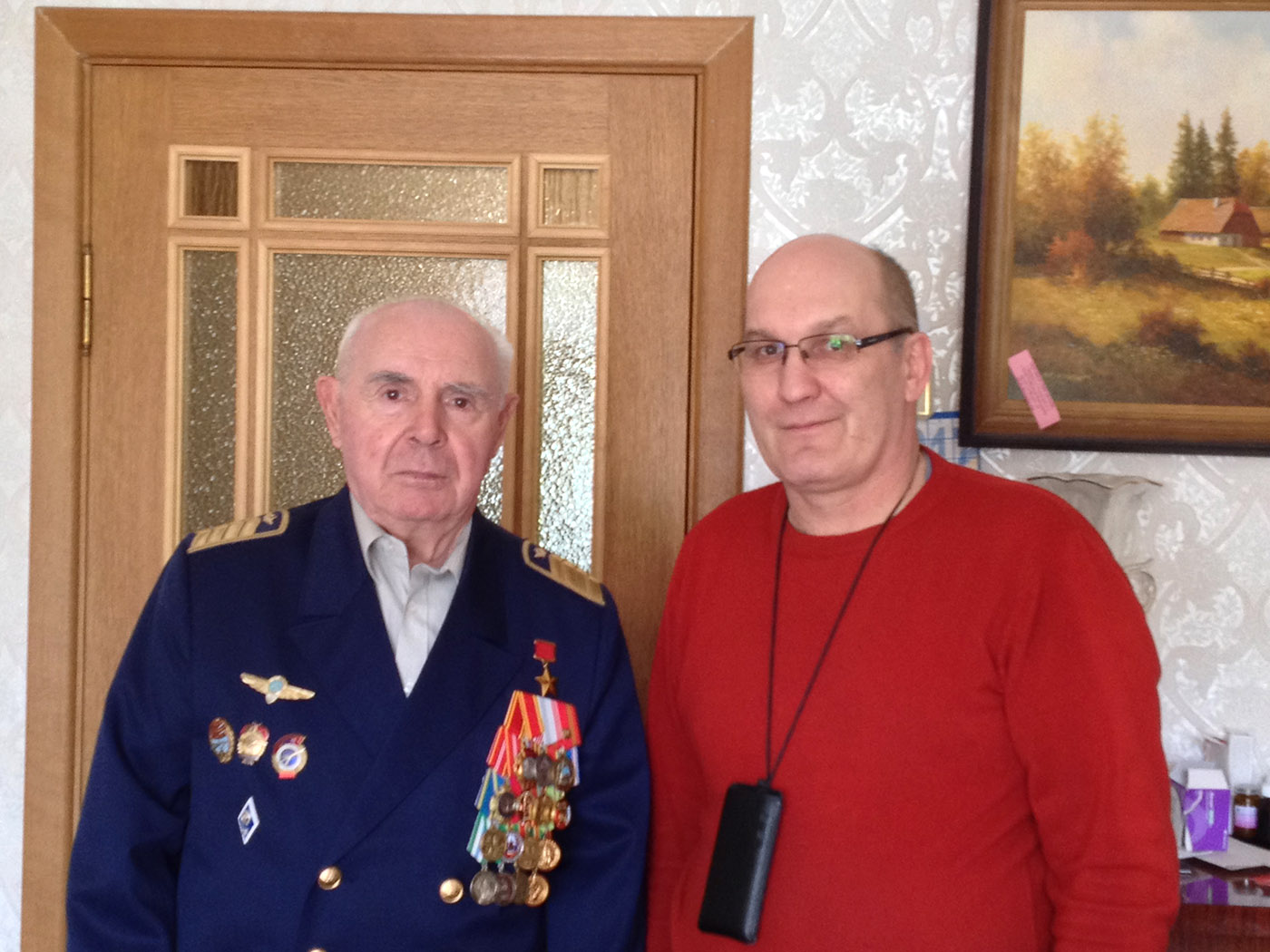 I.Kashin and K.Chirkin
Interview by Oleg Korytov and Konstantin Chirkin
I.Kashin and K.Chirkin
Interview by Oleg Korytov and Konstantin Chirkin
Edited by Oleg Korytov and Igor Zhidov
English edition by Jason Moore

 Разделы сайта
Разделы сайта
